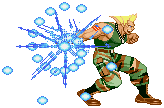|
||||||
|
[ updates ] [ articles ] [ media ] [ notebook ] [ gallery ] [ links ] [ help ] [ contact ] |
SF2 Engine Randomness Rundown
By Maj True randomness doesn't exist in computer programs - at least not in any twentieth-century arcade game. Nonetheless, the entire SF2 series exhibits a great number of variable outcomes, whether implemented intentionally or accidentally. Every instance of luck is governed by a combination of discernable factors, including frame-specific player inputs and game clock. Many of the following examples have been well-documented on fighting game forums while others are less widespread. Damage Variance Each attack's damage output fluctuates within an assigned range. Chosen values are subject to further modifications based on lifebar levels, character traits, and other systematic scaling considerations. On average, raw offensive power was gradually reduced from World Warrior to Super Turbo. Dizzy System Nearly all aspects of the dizzy process are randomized, including severity of punishment required to inflict dizziness, choice of revolving icons, and preset stun duration before mashing. In fact in CPS1 titles, controller inputs continue to influence symbol selection even after a character is knocked dizzy, since icons don't appear in WW, CE, and HF until the stunned fighter stands back up. Those circling symbols do have an established hierarchy of endurance, with recovery from stars being the easiest, followed by birds, angels, and finally grim reapers. To parallel the damage reduction trend, overall offensive dizzy potential has been toned down progressively from WW to ST. Input Window Leniency Individual components of a command sequence need not be performed contiguously. The maximum tolerable delay changes from one scenario to the next, often dramatically. Although the worst cases are still forgiving enough to satisfy essential competitive demands, this phenomenon has been known to complicate attempts at certain advanced exhibition combos. Charge Time Each charge special carries its own specified minimum charge time. However, in many instances this period is extended by one or two frames. It's nearly impossible to detect amidst combat and rarely acts as the breaking point in exhibition combo design. Hit Stun Animation Whenever struck by normal moves while ducking, every character displays a single crouched reeling animation. On the other hand, all characters are equipped with two standing hit stun animations. Most of the time, the choice of reaction follows intuitively from the attack's visual angle. However, assorted mid-level attacks are capable of causing either type of standing hit stun animation, particularly within combos. Hit box differences set the pair apart - to an especially pronounced degree for some characters. Naturally, all blood and vomit effects occur unpredictably. Throw Priority When opponents attempt throws simultaneously and both targets are equally legitimate, the victor is elected randomly. Obviously throws can't trade and not even ST throw escapes negate all harm. Given these grappling scheme characteristics, there's really no viable alternative approach. A clear casualty must be determined at every encounter. Victory Pose Selection At the end of each round, the winner is declared via routine ceremony. Everyone has a repertoire of two or three celebrations to enact on these occasions, one of which is chosen arbitrarily. Bonus Stage Physics On the second bonus stage, wooden barrels appear according to a fixed pattern. However, their landing spot, rolling direction, and durability are all matters of chance. Likewise, anytime oil drums become airborne on the third bonus stage, their trajectories are randomly generated. In other words, there's no physics engine to be found here; it's all smoke and mirrors. 512 Special and 512 Guard Apparently the designers of Street Fighter II wanted to expose players to the fighters' special moves as a way to entice newcomers into digging deeper and mastering complex controls. To this end, they programmed a 1-in-512 possibility of standard button presses converting instantly into special moves. Of course, if character isn't in a position to attack, the input is ignored as usual. Furthermore, normal moves can not be interrupted in this manner, so mashing rapid-fire weak attacks won't work. Oddly enough, there's also a 1-in-512 chance of blocking an oncoming attack, even without holding any defensive direction. Both 1/512 idiosyncrasies are exclusive to WW, having been eliminated by CE. Shoto Red Fireball Sometimes in the CPS1 games, Ryu and Ken's trademark blue fireball comes out red instead. Vega's Claw Gimmick As the only cast member to utilize a weapon, Vega possesses superior combat range. Opponents can compensate by disarming Vega, but it takes an inconstant number of hits to dislodge the claw. Blocked and successful attacks both count, but the knockout strike is ineligible. Superfreeze Duration Nearly all Capcom fighting games seem to struggle with superfreeze inconsistencies. There's always that one-frame margin of error in calculating super move startup. Consequently, borderline combos such as Ryu's c.LK -> c.LK xx Shinkuu Hadoken fail half the time, even when timed perfectly. Turbo Speed Frameskip In order to achieve accelerated game speeds without altering display refresh rate, HF and ST both omit the corresponding ratio of internal frames from the screen. Unfortunately, these relegations follow a seemingly erratic, fluctuating configuration. Skipped frames still resolve according to standard game rules, but the opportunity to input commands at those junctures is revoked. Most practical combos maintain so much built-in tolerance, that frame skipping remains imperceptible along the course of a normal match. With exhibition combos, however, flexibility is sacrificed for precision. Therefore, skipped frames create all sorts of troublesome obstacles, compelling many combo video makers to avoid turbo speed settings altogether.
Special thanks to NKI, T.Akiba, Choiboy, and omni for their efforts in deciphering all this madness. For further information concerning many aforementioned concepts, browse through the old school Street Fighter technical info over at The Complete NKI Collection.
|
|||||



